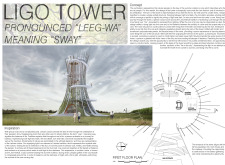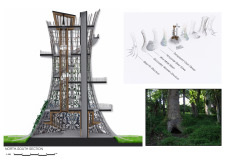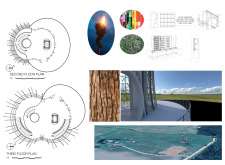5 key facts about this project
At its core, the Ligo Tower is designed to facilitate social interaction and cultural experiences. The project incorporates elements that encourage exploration and connection among visitors, reflecting the spirit of the Jāņi festival. The architecture of the tower features two intertwined forms, resembling the oak and linden trees, which symbolize growth, resilience, and community values. This unique representation of nature is not only visually appealing but also serves as a reminder of the deep-rooted connection Latvian culture has with its environment.
The functionality of the Ligo Tower is carefully considered, with a central core that guides visitor movement through a series of open and interactive spaces. Each floor is designed to accommodate social gatherings and cultural activities, promoting a sense of community. The pathways within the tower encourage a journey of discovery, where visitors can navigate through the structure and partake in both structured and spontaneous experiences.
A notable aspect of the design is its innovative use of materials. The structure utilizes polycarbonate translucent panels that allow natural light to penetrate deep into the interior, creating inviting and warm spaces. Steel frames provide necessary structural support, ensuring stability while allowing for expansive views of the surrounding landscape. The incorporation of wood adds warmth and richness to the interior environment, creating a tactile experience that contrasts with the sleekness of the other materials.
The integration of greenery into the project is a significant design approach that enhances its ecological purpose. Wire mesh elements allow for the growth of plants, reinforcing the connection between architecture and nature. This not only helps to blend the tower into its natural surroundings but also emphasizes sustainability as a core principle of the design. The lighting designed throughout the tower effectively balances light and shadow, enriching the spatial experience and providing a serene atmosphere for reflection and gathering.
In examining the unique design approaches employed in the Ligo Tower, it is noteworthy how the project bridges the gap between cultural representation and modern architectural language. The dynamic form of the tower embodies the concept of movement, mimicking the sway of the trees while encouraging vertical exploration. This thoughtful integration of form and function fosters an environment conducive to learning and celebration, reflecting the principles of Latvian folklore.
The Ligo Tower stands as an architectural representation of community, nature, and cultural celebration. Its design emphasizes the importance of connection—between the structure and its environment, between individuals, and between tradition and modernity. For those interested in architectural exploration, further details about the project can be discovered through its architectural plans, sections, designs, and innovative ideas. This project invites a deeper understanding of how architecture can serve both functional and cultural purposes, enriching the community and celebrating heritage.


























